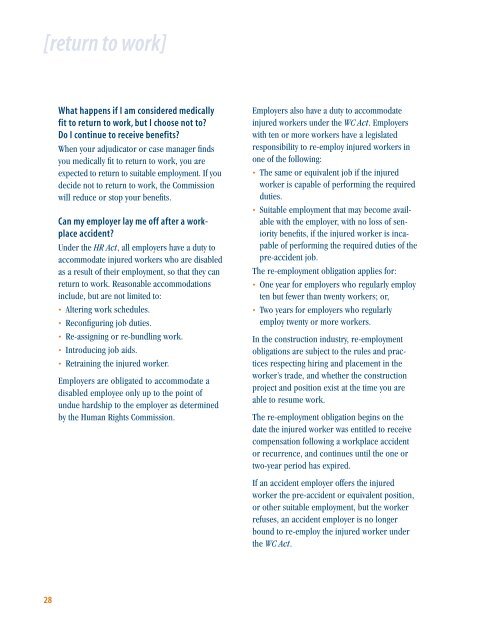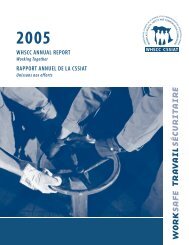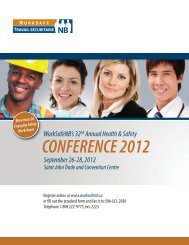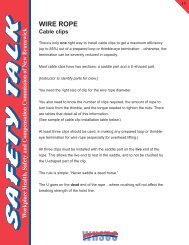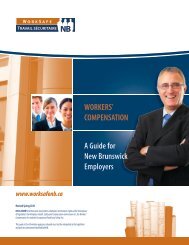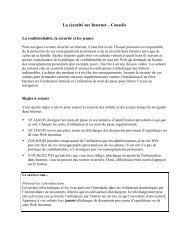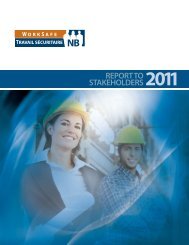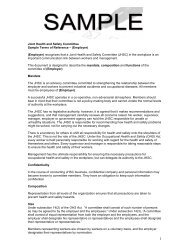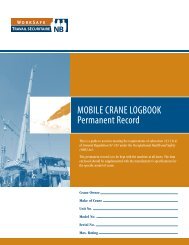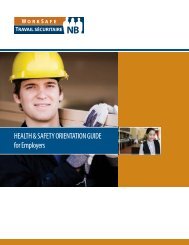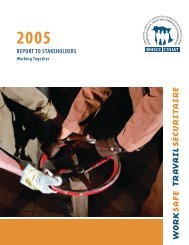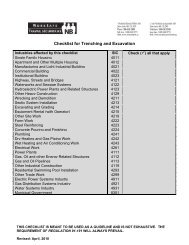Workers - WorkSafeNB
Workers - WorkSafeNB
Workers - WorkSafeNB
Create successful ePaper yourself
Turn your PDF publications into a flip-book with our unique Google optimized e-Paper software.
[return to work]<br />
What happens if I am considered medically<br />
fit to return to work, but I choose not to?<br />
Do I continue to receive benefits?<br />
When your adjudicator or case manager finds<br />
you medically fit to return to work, you are<br />
expected to return to suitable employment. If you<br />
decide not to return to work, the Commission<br />
will reduce or stop your benefits.<br />
Can my employer lay me off after a workplace<br />
accident?<br />
Under the HR Act, all employers have a duty to<br />
accommodate injured workers who are disabled<br />
as a result of their employment, so that they can<br />
return to work. Reasonable accommodations<br />
include, but are not limited to:<br />
• Altering work schedules.<br />
• Reconfiguring job duties.<br />
• Re-assigning or re-bundling work.<br />
• Introducing job aids.<br />
• Retraining the injured worker.<br />
Employers are obligated to accommodate a<br />
disabled employee only up to the point of<br />
undue hardship to the employer as determined<br />
by the Human Rights Commission.<br />
Employers also have a duty to accommodate<br />
injured workers under the WC Act. Employers<br />
with ten or more workers have a legislated<br />
responsibility to re-employ injured workers in<br />
one of the following:<br />
• The same or equivalent job if the injured<br />
worker is capable of performing the required<br />
duties.<br />
• Suitable employment that may become available<br />
with the employer, with no loss of seniority<br />
benefits, if the injured worker is incapable<br />
of performing the required duties of the<br />
pre-accident job.<br />
The re-employment obligation applies for:<br />
• One year for employers who regularly employ<br />
ten but fewer than twenty workers; or,<br />
• Two years for employers who regularly<br />
employ twenty or more workers.<br />
In the construction industry, re-employment<br />
obligations are subject to the rules and practices<br />
respecting hiring and placement in the<br />
worker’s trade, and whether the construction<br />
project and position exist at the time you are<br />
able to resume work.<br />
The re-employment obligation begins on the<br />
date the injured worker was entitled to receive<br />
compensation following a workplace accident<br />
or recurrence, and continues until the one or<br />
two-year period has expired.<br />
If an accident employer offers the injured<br />
worker the pre-accident or equivalent position,<br />
or other suitable employment, but the worker<br />
refuses, an accident employer is no longer<br />
bound to re-employ the injured worker under<br />
the WC Act.<br />
28


